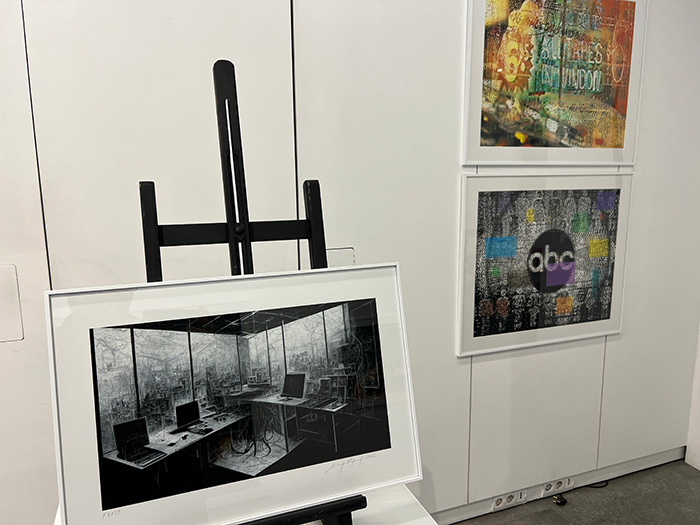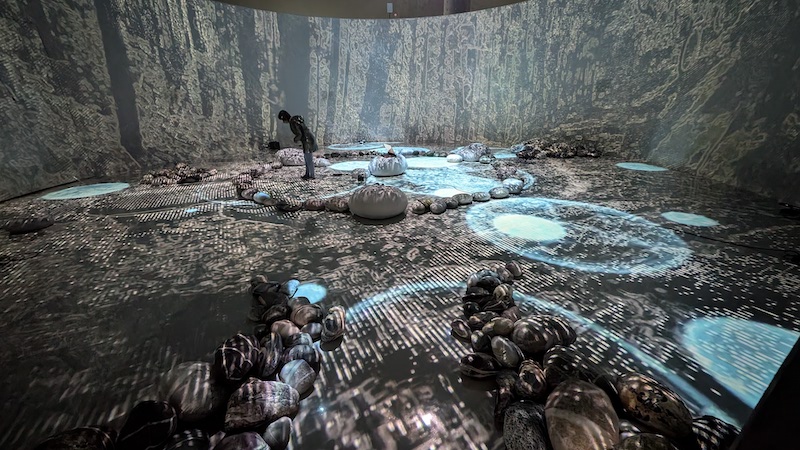
Develop your technical literacy
and creative design skills
For more information, visit:
UCSB Summer Sessions website

Develop your technical literacy
and creative design skills
For more information, visit:
UCSB Summer Sessions website
The Loop Lab Busan Exhibition is a collaborative citywide event spanning approximately 20 cultural spaces, including public and private museums, alternative spaces, and galleries throughout Busan, Korea.

www.looplabbusan.com/exhibition
www.ocadu.ca/events-and-exhibitions/research-talks-dr-haru-ji
The software creates personalized visuals and abstract art in an immersive landscape that is based on the memories of the crew members. The news articles highlight their work on a software pipeline that was being used at the St. Kliment Ohridski base on Livingston Island, Antarctica.
For more information, please see:
UCSB's The Current news magazine article:
New frontiers for well-being in Antarctica and isolated spaces.
Santa Barbara Independent article:
UC Santa Barbara Researchers Design Tools to Combat Isolation in Extreme Environments.


Iason Paterakis, Nefeli Manoudaki - AI driven visuals: Icescape

Iason Paterakis, Nefeli Manoudaki - AI driven visuals: Beach

Iason Paterakis, Nefeli Manoudaki - AI driven visuals: Plains
The title of the NSF award is Dynamic Control Systems for Manual-Computational Fabrication. Professor Jacobs was awarded the NSF Career Award to further her research in integrating skilled manual and material production with computational fabrication.
The CAREER Program offers the NSF's most prestigious awards in support of early-career faculty who have the potential to serve as academic role models in research and education and to lead advances in the mission of their department or organization.
Professor Jacobs thanks all of the amazing members the Expressive Computation Lab whose research contributed the intellectual foundations of this award.
UCSB News: Making Automation More Human Through Innovative Fabrication Tools
NSF link: Dynamic Control Systems for Manual-Computational Fabrication
George Legrady: Scratching the Surface. Digital Pictures from the 1980s to Present.
RCM Galerie, Paris
Tuesday, December 17 2024 to Sunday February 16, 2025
32 rue de Lille, 75007
Tue-Fri 2pm-7pm & by appointment
whitehotmagazine.com/articles/32-rue-de-lille-paris/6789



α-Forest: An Immersive Sound and Light Journey Through Inner-consciousness Exploration
Production Team: Olifa Hsieh (MAT visiting scholar), Timothy Wood (MAT researcher), and Weihao Qiu (MAT PhD student).
The subconscious is where your intrinsic qualities thrive; where seeds of inspiration reside; and where many impulses, emotions, and thoughts are hidden and never expressed. Sometimes they only appear in dreams.
α-Forest is a participatory immersive theater with healing qualities, created by the following three artists: Olifa Ching-Ying Hsieh, Timothy Wood, and Weihao Qiu. The work integrates electronic sound, interactive design, and AI algorithmic imaging technology to capture the audience’s brainwaves (Electroencephalography, EEG) and collect data on their physical movements, resulting in real-time co-created content. At a residency base offered by the Experimental Forest of National Taiwan University, the artists collected unique forest sounds from a mountainous area in central Taiwan, Nantou. They also visited the region’s indigenous tribe and learned about their culture.
More about the exhibition (PDF)


The National Taiwan Museum of Fine Arts
From the author/composer:
"For this album I have assembled a collection of contrasting works from the archives. Some have previously been released, others not. Three pieces: Sculptor, Touche pas, and Bubble chamber are based on the microsound techniques of granular synthesis and micro-montage. By contrast, Modulude, Clang-tint, and Still life were conceived before my microsound period."
"For any given piece, my compositional practice usually takes years. For example, Modulude was initially conceived in 1998 and finished 23 years later. What I call my microsound period began in 1998 and culminated in the book Microsound (The MIT Press) and the album POINT LINE CLOUD (2004), re-issued by the Presto?! label (Milan) in 2019. Sculptor appeared on that album. Clang-tint traces back to 1991. It was finally released in 2021 by the SLOWSCAN label (’s-Hertogenbosch, The Netherlands) in a limited edition LP. Prior to this, the first movement of Clang-tint, Purity, appeared on the album CCMIX Paris (2001 Mode Records, New York). The origins of Still life date back even further, to the 1980s. Touche pas appeared on the DVD FLICKER TONE PULSE (2019 Wergo Schallplatten, Mainz). Bubble chamber is a new release."
ellirecords.bandcamp.com/album/electronic-music-1994-2021


|

|

|

|

|

|

Media Arts and Technology (MAT) at UCSB is a transdisciplinary graduate program that fuses emergent media, computer science, engineering, electronic music and digital art research, practice, production, and theory. Created by faculty in both the College of Engineering and the College of Letters and Science, MAT offers an unparalleled opportunity for working at the frontiers of art, science, and technology, where new art forms are born and new expressive media are invented.
In MAT, we seek to define and to create the future of media art and media technology. Our research explores the limits of what is possible in technologically sophisticated art and media, both from an artistic and an engineering viewpoint. Combining art, science, engineering, and theory, MAT graduate studies provide students with a combination of critical and technical tools that prepare them for leadership roles in artistic, engineering, production/direction, educational, and research contexts.
The program offers Master of Science and Ph.D. degrees in Media Arts and Technology. MAT students may focus on an area of emphasis (multimedia engineering, electronic music and sound design, or visual and spatial arts), but all students should strive to transcend traditional disciplinary boundaries and work with other students and faculty in collaborative, multidisciplinary research projects and courses.